Definition
Vertical integration is a strategy used by a company to gain control over its suppliers or distributors in order to increase the firm’s power in the marketplace, reduce transaction costs and secure supplies or distribution channels.
Forward integration is a strategy where a firm gains ownership or increased control over its previous customers (distributors or retailers).
Backward integration is a strategy where a firm gains ownership or increased control over its previous suppliers.
What is vertical integration?
Vertical integration (VI) is a strategy that many companies use to gain control over their industry’s value chain. This strategy is one of the major considerations when developing corporate level strategy. The important question in corporate strategy is, whether the company should participate in one activity (one industry) or many activities (many industries) along the industry value chain. For example, the company has to decide if it only manufactures its products or would engage in retailing and after-sales services as well. Two issues have to be considered before integration:
- Costs. An organization should vertically integrate when costs of making the product inside the company are lower than the costs of buying that product in the market.
- Scope of the firm. A firm should consider whether moving into new industries would not dilute its current competencies. New activities in a company are also harder to manage and control. The answers to previous questions determine if a company will pursue none, partial or full VI.
The example below illustrates a general industry value chain and none, partial or full VI of a corporate operating in that industry.
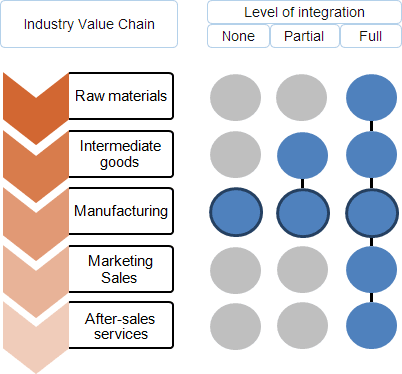
Difference between vertical and horizontal integrations
VI is different from horizontal integration, where a corporate usually acquires or mergers with a competitor in a same industry. An example of horizontal integration would be a company competing in raw materials industry and buying another company in the same industry rather than trying to expand to intermediate goods industry. Horizontal integration examples: Kraft Foods taking over Cadbury, HP acquiring Compaq or Lenovo buying personal computer division from IBM.
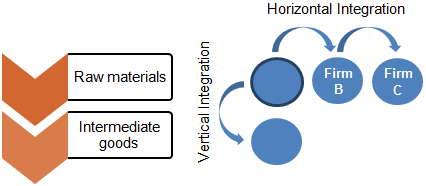
Types of vertical integration
Firms can pursue forward, backward or balanced VI strategies.
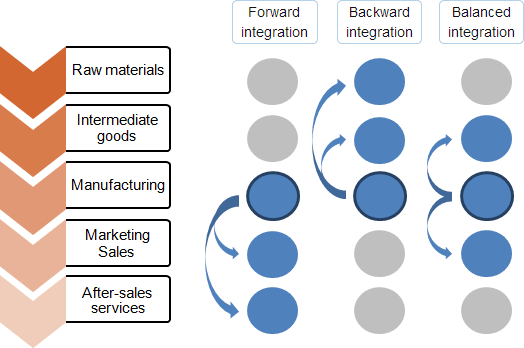
Forward integration
If the manufacturing company engages in sales or after-sales industries it pursues forward integration strategy. This strategy is implemented when the company wants to achieve higher economies of scale and larger market share. Forward integration strategy became very popular with increasing internet appearance. Many manufacturing companies have built their online stores and started selling their products directly to consumers, bypassing retailers. Forward integration strategy is effective when:
- Few quality distributors are available in the industry.
- Distributors or retailers have high profit margins.
- Distributors are very expensive, unreliable or unable to meet firm’s distribution needs.
- The industry is expected to grow significantly.
- There are benefits of stable production and distribution.
- The company has enough resources and capabilities to manage the new business.
Backward integration
When the same manufacturing company starts making intermediate goods for itself or takes over its previous suppliers, it pursues backward integration strategy. Firms implement backward integration strategy in order to secure stable input of resources and become more efficient. Backward integration strategy is most beneficial when:
- Firm’s current suppliers are unreliable, expensive or cannot supply the required inputs.
- There are only few small suppliers but many competitors in the industry.
- The industry is expanding rapidly.
- The prices of inputs are unstable.
- Suppliers earn high profit margins.
- A company has necessary resources and capabilities to manage the new business.
Balanced integration strategy is simply a combination of forward and backward integrations.
Vertical integration examples
Smartphones Industry
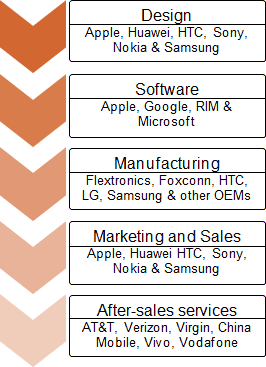
Automotive Industry
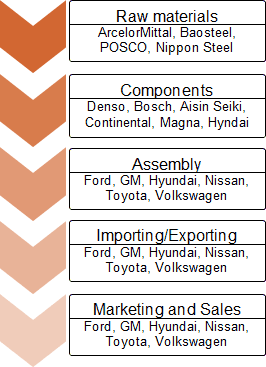
Oil Industry
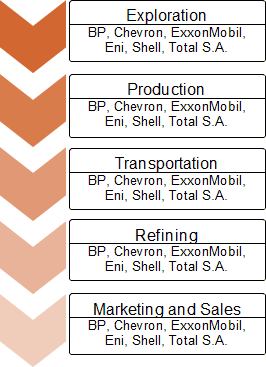
Media Industry
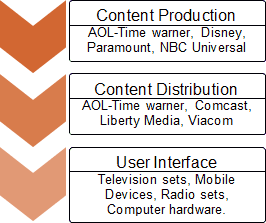
Many businesses around the world use vertical integration to gain competitive advantage. Some of the examples include: Apple Inc., Samsung Electronics, The Coca Cola Company, Alphabet (Google) Inc., Ford Motor Company, Toyota Motor Corporation and many other businesses.
Advantages
Advantages of the strategy:
- Lower costs due to eliminated market transaction costs.
- Improved quality of supplies.
- Critical resources can be acquired through VI.
- Improved coordination in supply chain.
- Greater market share.
- Secured distribution channels.
- Facilitates investment in specialized assets (site, physical-assets and human-assets).
- New competencies.
Disadvantages
Disadvantages of VI:
- Higher costs if the company is incapable of managing new activities efficiently.
- The ownership of supply and distribution channels may lead to lower quality products and reduced efficiency because of the lack of competition.
- Increased bureaucracy and higher investments leads to reduced flexibility.
- Higher potential for legal repercussion due to size (An organization may become a monopoly).
- New competencies may clash with old ones and lead to competitive disadvantage.
Alternatives to VI
This strategy may not always be the best choice for an organization due to a lack of sufficient resources that are needed to venture into a new industry. Sometimes the alternatives to VI offer more benefits. The available choices differ in the amount of investments required and the integration level. For example, short-term contracts require little integration and much less investments than joint ventures.
Vertical Integration Alternatives
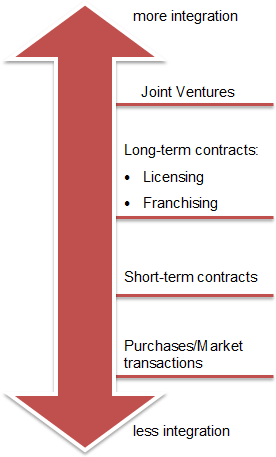
Sources
- Wikipedia (2013). Vertical Integration. Available at: https://en.wikipedia.org/wiki/Vertical_integration
- Stuckey, J. & White, D. (1993). When and when not to vertically integrate. McKinsey & Company.

